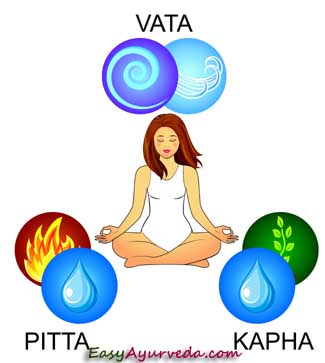Functions Of Doshas In Balance In The Body – Prakrita Dosha Karma
Article by Dr Raghuram Y.S. MD (Ay) & Dr Manasa, B.A.M.S
Sama dosha or prakruta dosha means doshas in a state of equilibrium. Doshas in a balanced state is one of the determinants of healthy person.

Table of Contents
Sama Vata Karma
Sama Vata Dosha karmas (functions of normal vata)
Below mentioned are the normal functions of Vata –
Utsaha – enthusiasm and drive to do work is initiated by normal vayu. Vayu controls the body dynamics and mechanisms. All other elements are inert except vata. When vata propels the body components and motivates them there is enthusiasm and energy to do work. This is a sign of life and life activities.
Uchchwasa & Nishwasa – Uchchwasa means breathing in air. Nishwasa means breathing out the air. Both these are events of normal breathing pattern. When uchchwasa and nishwasa are uninterrupted, the body is oxygenated properly. This is carried by normal vata, mainly prana, udana and vyana vayus.
Cheshta – sensory and motor movements, skeletal movements, organic and peristaltic movement or transportation of any materials within the body like circulation of blood, nerve conduction etc
Read related: Understand Vata Dosha By Its Functions
Vega pravarthana – natural expulsion of natural urges created by the body i.e. urge to defecate etc. is carried out by normal vata. The body urges are 13 in number. They are –
- Adho vata vega (urge to remove flatus, fart reflex)
- Vit or pureesha vega (urge to defecate, stool reflex)
- Mutra vega (urge to urinate, urination reflex)
- Kshavathu vega (urge to sneeze, sneeze reflex)
- Trishna vega (urge to drink water, thirst reflex)
- Kshudha vega (urge to consume food, hunger reflex)
- Nidra vega (urge to sleep, sleep reflex)
- Kasa vega (urge to cough, cough reflex)
- Shrama shwasa (urge for hurried breathing following exercise)
- Jrimbha vega (urge to yawn, yawning reflex)
- Ashru vega (urge to cry, weeping reflex)
- Chardi vega (urge to vomit, puke reflex)
- Retas or shukra vega (urge to ejaculate semen, ejaculatory reflex).
Vegas are natural discharges which keep the body healthy and clean, they are motivated and mobilized by vata.
Related reading – vega dharana
Dhatunaam samyak gati – proper transportation of tissues and building blocks needed for their formation (nutrition to tissues) is carried out by normal through the srotases (channels and duct system of the body)
Akshaanaam patavena cha – the sensory functions and the perception of sense objects through the sense organs, the conduction of sensory information to the mind and intellect, storage of information, processing and transforming of the sensory information into storable and understandable knowledge and reproduction of the same knowledge when needed (memory) is conducted by smooth functioning of normal vata. At the same time the motor responses for actions to be conducted in accordance to sensory information through the motor organs is also controlled by normal vata. The functions of the mind which is both a sensory and motor entity (ubhayendriya) is also under the control of normal vata.
Sama Pitta Karma
Sama Pitta karmas (functions of normal pitta)
Pakti – digestion of food is conducted by pitta, mainly pachaka pitta which is located in the stomach and intestine. In the body pitta represents fire. When the pitta is in normalcy, the food which we take is properly digested. The digested food is absorbed in the form of nutrient juice which is put into circulation through the heart and blood vessels. This nutrient juice on reaching the tissues of the body will nourish them. .
Ushma – maintenance of body temperature is one of the chief functions of normal pitta. Normal heat of the body is one of the indicators of life. Heat also reflects normal metabolism which is reflection of normal body activities and immunity.
Darshana – normal pitta helps in maintenance of normal vision. Eye is called as the most important sense organ. Alochaka pitta situated in the eye along with sadhaka pitta located in the head helps in maintaining the normal vision when they are in a state of normalcy.
Kshut (Kshuda) – feeling of hunger at proper time is also a sign of good health and also an indicator that the previously taken food has been digested. All diseases are caused by inability of the digestive fire to digest food. Proper digestion of food is essential for proper digestive juices to be formed which in turn provides nutrition to the body components which is the basis of normally progressing life activities. Feel of hunger is the function of normal pitta. This is caused by hot quality of pitta.
Trut (Trishna) – timely manifestation of thirst is a function of normal pitta. Thirst is an indication of water imbalance. It also reflects high pitta condition in the body which in turn reflects high quantum of heat in the body. Pitta acts as thermal regulator and whenever its heat increases it causes thirst (feedback mechanism) to compensate the water loss in the body or for water balance to be restored. Apart from fire, water is also a component of pitta. (Note – this is only related to normal thirst and not pathological thirst).
Ruchi – taste towards food or interest towards consumption of food is a function of sama pitta. One can relish the taste of the food only when there is proper hunger and when the previously taken food has been comprehensively digested.
Prabha – Prabha means luster. Ones reflection is one’s identity and this prabha is due to normal pitta. This is due to balanced bhrajaka pitta, the pitta sub-type located in the skin.
Medha, Dhee, Dhairya – Medha means reasoning power. Dhee is intellect. Dhairya is courage. All these help in proper mental living of an individual. All these are controlled by normally functioning pitta, especially the sadhaka pitta and alochaka pitta (located in the brain and eyes) respectively.
Tanu Mardava – Tanu mardava means smoothness of the body. This texture is provided by the smooth quality, unctuous quality and liquid quality of pitta. Tanu mardavata is bestowed by balanced pitta, especially bhrajaka pitta.
Read related: Understand Pitta Dosha By Its Functions
Sama Kapha Karma
Sama / Prakruta Kapha karmas (functions of normal kapha)
Sthiratva – sthiratva means stability. The stability to the body and body components is provided by normally functioning kapha. Kapha is made up of predominance of water element and earth element. The combination of water and earth form a cementing substance which forms a supporting and binding matrix for the body components. If the body needs to exist and function as a single entity there should be a proper binding among the body components, mainly the cells and tissues which make up the whole body. This adhesiveness needed for integrity of the body components is provided by normal kapha.
Snigdhatva – snigdhatwa means unctuousness. Kapha and pitta provide this unctuousness to the body. Fat whose function is providing unctuousness to the body components is a member of kapha family. The unctuousness of the body components help in easy functioning and prevent wear and tear. This is bestowed by the unctuous and smooth qualities of kapha.
Sandhi bandha – sandhi bandha means integrity of the bony joints of the body. This is provided by the normal kapha, mainly normal shleshaka kapha, a sub-type of kapha residing in the bony joints. This helps in easy movements of skeletal joints and helps in effortless motion and locomotion. Sandhi also means the junction between two structures like junction between cells, tissues and organs.
Kshama – vyadhi kshamatva means tolerance power or immunity. Immunity is the capability of the body system to fight against disease or disease causing agents. Immunity is based on the integrity of the body components and tissues and this stability is provided by kapha. Normal kapha is called balasa or bala, both means strength, integrity or immunity.
Read related: Understand Kapha Dosha By Its Functions
Importance of Sama Dosha
Importance of having the knowledge of functions of Doshas in balance
Every physician should have comprehensive knowledge of the functions of normal doshas because they are indicators of health. Any deviation from these normal functions indicate that the doshas are disturbed which also gives a clue towards understanding the pathogenesis of many diseases. It is always wise to know what is normalcy since it forms the foundation of understanding the pathology.
Click to Consult Dr Raghuram Y.S. MD (Ayu) – Email / Skype











One comment
Deniz
Fabulous as always, thank you so much